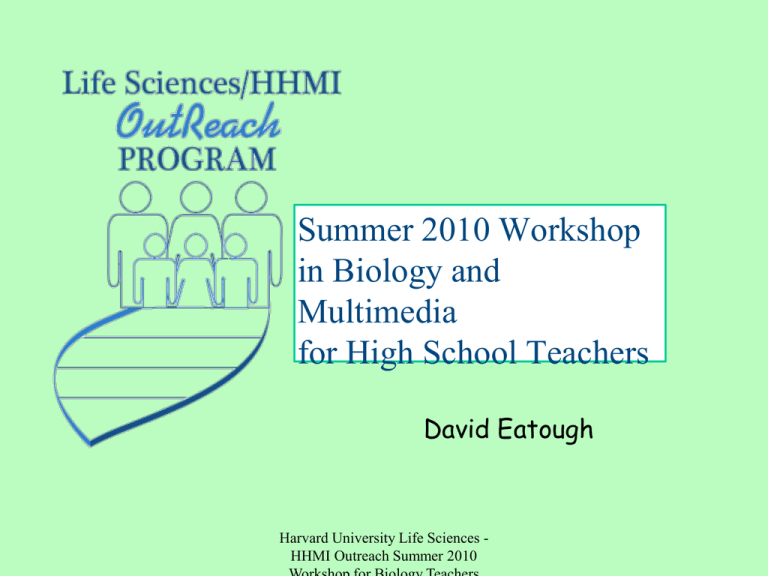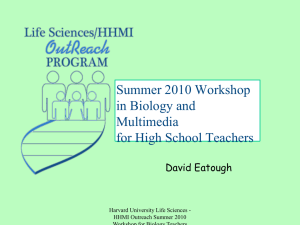Presentation
advertisement

Summer 2010 Workshop in Biology and Multimedia for High School Teachers David Eatough Harvard University Life Sciences HHMI Outreach Summer 2010 What is Biodiversity? Biodiversity is the variety or richness of life at all structural levels (molecular/genetic, species, ecosystem). It is an essential renewable resource. It is exploited and depleted as a result of the “Tragedy of the Commons” phenomenon. The current rate of biodiversity loss is comparable to previous extinction events. Why is biodiversity important? Biodiversity provides us with: Natural Resources (food, water, wood, energy, and medicines) Natural (Ecosystem) Services including: air and water purification, soil fertility, waste disposal, pest control) Aesthetic pleasure “The decline of Earth’s biodiversity is an unintended consequence of multiple factors that have been enhanced by human activity. They can be summarized by the acronym HIPPO, with the order of the letters corresponding to their rank in destructiveness.” H Habitat loss, including that caused by human-induced climate change. I Invasive species (harmful aliens, including predators, diseases, and competitors that displace native species P Pollution P Population, Human overpopulation to be exact, a root cause of the other four factors O Overharvesting, Overuse (hunting, fishing, gathering) E. O. Wilson “The Creation” Habitat loss/destruction http://en.wikipedia.org/wiki/File:Lacanja_burn.JPG Habitat loss is the greatest reason for biodiversity loss. Habitat loss is due to: • Conversion of natural areas to farms, houses, etc • Fragmentation of ecosystems by human activities, housing, transportation, agriculture etc. • Simplification of genetic diversity and complex ecosystems by planting/selecting monocultures. Invasive / Exotic Species Invasive, exotic species introduced from elsewhere outcompete native species because they: Have no natural predators Colonize disturbed habitats quickly Have a high biotic potential (r-species) http://en.wikipedia.org/wiki/File:Kudzu_on_trees_in_Atlanta,_Georgia.jpg http://en.wikipedia.org/wiki/File:Bufo_marinus_from_Australia.JPG Cane Toads – The Conquest movie Pollution Pollution (Oil spills, human agricultural waste, fertilization, pesticides, acid deposition, greenhouse gases etc) caused by human activities has a negative effect on biodiversity http://en.wikipedia.org/wiki/File:AlfedPalmersmokestacks.jpg Population, Human overpopulation that is. 6.8 Billion and counting. The expansion of human population and affluence, especially in the developing world harms natural ecosystems. http://en.wikipedia.org/wiki/File:World_population.svg Overharvesting, Overuse, Overexploitation Overhunting, overfishing, destructive harvesting practices (cyanide, dynamite), illegal trade, exotic pet industry http://en.wikipedia.org/wiki/File:Fishing_down_the_food_web.jpg Raven, Berg, and Hassenzahl put it this way Human Population Increase Land use change (Habitat loss) Increasing Economic Activity Increasing Economic Activity Increased use of technology Increased use of technology Social, political and cultural factors Social, political and cultural factors Indirect (Underlying causes) Direct causes Declining Biological Diversity Characteristics shared by many endangered species include: • • • • Low reproductive rate (biotic potential) Feed at high trophic levels (apex predator) Large body size Specialist Specialized feeding habits Specialized nesting and/or breeding areas Fixed migratory patterns Found in one place or region • Rare • Commercially valuable • Negative human interactions including attacks on people or livestock How can humanity protect biodiversity? http://en.wikipedia.org/wiki/File:Siproeta_epaphus_Galawebdesign.jpg Important Laws Protecting Biodiversity Lacey Act (1900) forbids interstate commerce of illegally killed wildlife. Modifications of act prevent importing dangerous non-native species. Endangered Species Act (ESA) of 1973 makes it illegal to kill, trap, uproot (plants), modify the habitat of, or engage in commerce of an endangered species or its parts. To designate a species as endangered or threatened, Fish and Wildlife Service or National Oceanic and Atmospheric Administration must: • List species • Designate critical habitat areas where species is found • Develop a recovery plan to help species survive and thrive The rich variety of the natural world that Charles Darwin memorably imagined as an "entangled bank", and that E. O. Wilson labeled "biodiversity", is in crisis. The International Union for Conservation of Nature (IUCN) calculates that one-fifth of mammals and nearly one-third of amphibians are threatened with extinction. Some estimate that only half of the species alive today will survive to 2100. Others describe the pace of biodiversity loss as 100 times the rate of natural extinctions. Less-diverse ecosystems are less productive, less stable and less robust. So loss of biodiversity may weaken ecosystems and make them more fragile, especially in the face of climate change, with grave consequences for food security, among other things. Sara Abdulla, Chief Commissioning Editor, Nature March 2010 http://en.wikipedia.org/wiki/File:MEAConservationStrategies.jpg This summary of the relative effects by the year 2100 is a composite derived from calculations carried out for 12 individual terrestrial and freshwater ecosystems by O. E. Sala et al. (Science287, 1770–1774; 2000). Overall, changes in land use constitute the main estimated impact on biodiversity, but the pattern varies considerably for different ecosystems. According to Sala and colleagues' calculations, climate change will have the strongest effect on Arctic, alpine and boreal ecosystems, whereas biotic exchange (that is, invasion by non-native species) will exert its main influence in lakes.





